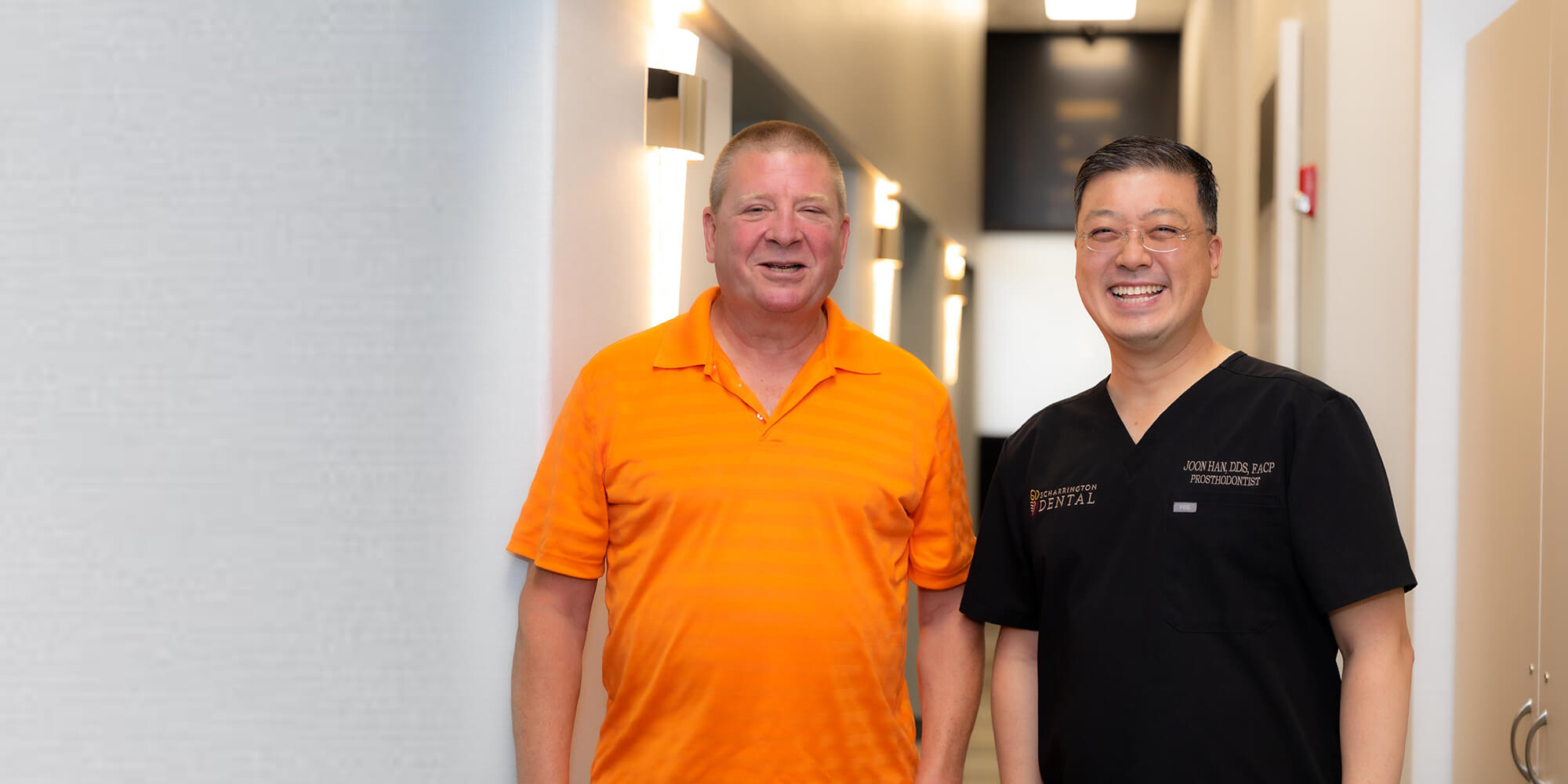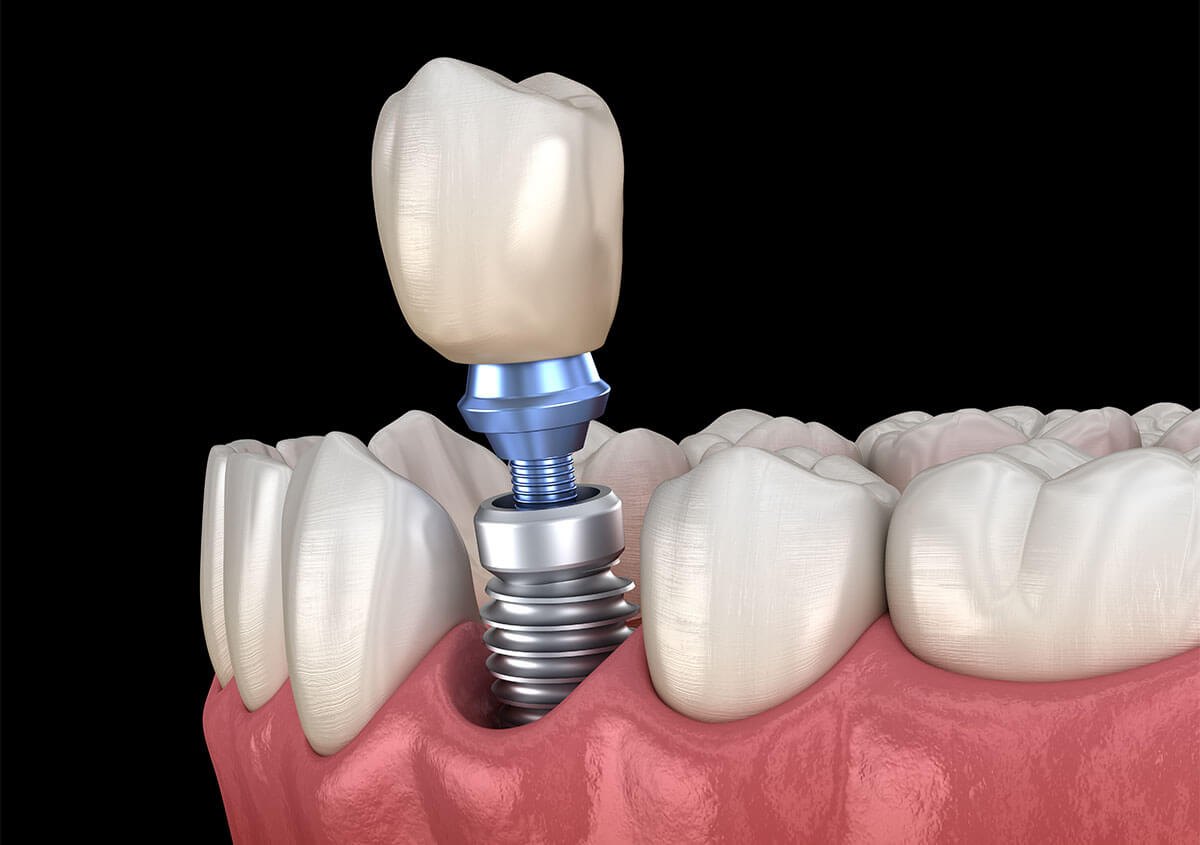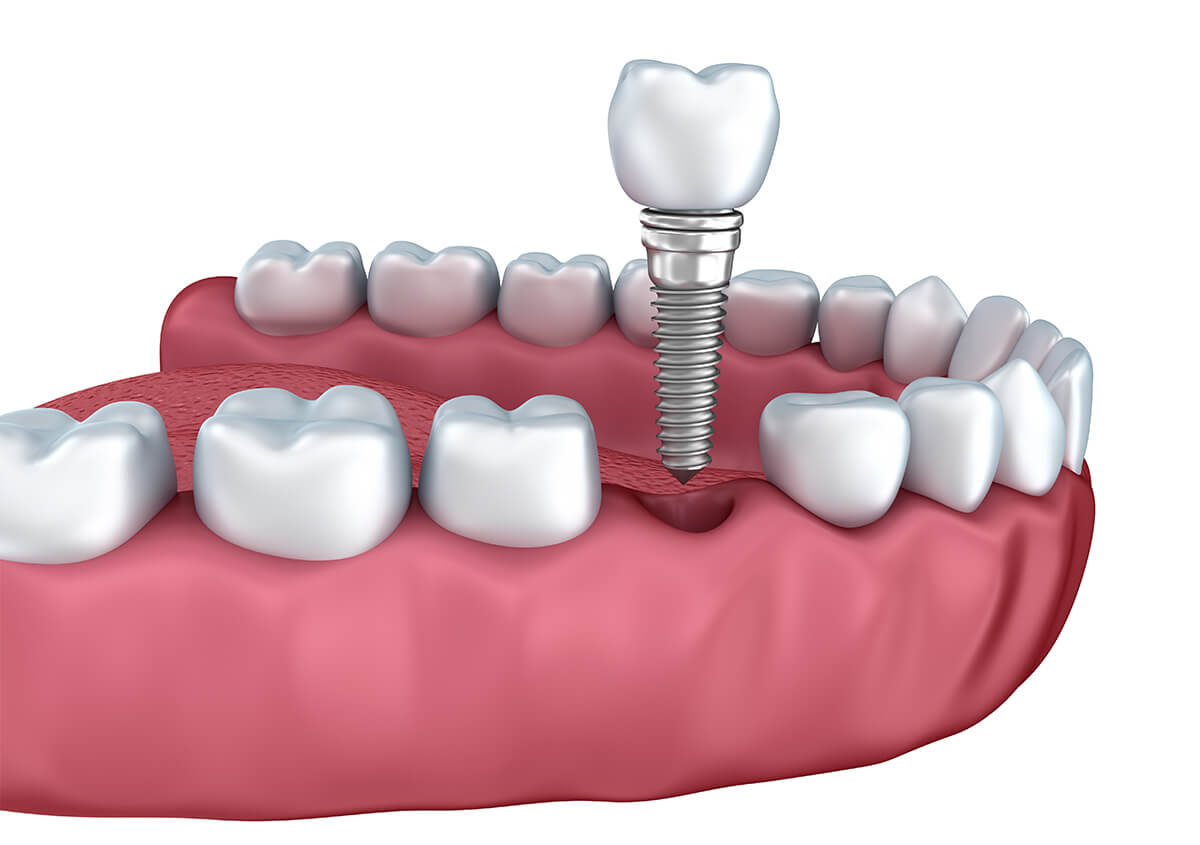See Our Tooth Replacement Specialist
Missing teeth cause many problems, whether you’ve lost one or several. Speaking and smiling is embarrassing. Eating is uncomfortable. Your self-esteem can suffer greatly as a result. Dental implants are the remedy that will lead to your brand-new smile! We provide comprehensive services relating to dental implants, including IV sedation and long-lasting restorations, under one roof. Unlike many practices, we both place and restore implants so you’ll never have to travel to multiple specialists. While bridges are a possible solution for a missing tooth, they can’t match the stability of a dental implant in Schaumburg, IL.
As a board-certified prosthodontist, Dr. Joon Han is a verified dental implant expert. Not only did he complete years of advanced, specialized training in dental implants and other restorative dentistry treatments, to maintain certification he stays ahead of all the newest technology and techniques in the field. His surgical training and deep understanding of oral and facial anatomy enable him to deliver exceptional functional and esthetic results even in complex cases. Few dental practitioners are better qualified to provide you such skilled dental implant care. After it, you’ll enjoy many, lasting and life-changing benefits.
Preserve Bone and Improve Your Smile with Dental Implants!

Main purpose of doing a dental implant is to preserve the bone structure once you lose the tooth. A lot of people have misconceptions of replace missing tooth, but the number 1 reason that you do that is to preserve the surrounding bone that supports the adjacent there. Because once you lose the bone and the areas start losing and not only does it affect the teeth adjacent to it, everything starts shifting towards that empty space, so now it compromises your appearance, and also the position of your teeth so that it affects how you eat and by putting a dental implant – the dental implant stimulates the bone around it, so it preserves the bone structure. Therefore you maintain that space for a long time. That is the number one reason that we place the dental implant there.
Here in our office, the dental implant is the best option that we can offer to our patient to replace your missing teeth. So the bridge commonly called a bridge or a fixed partial denture. Basically, we have to use – when you are missing the tooth, conventionally how it was done was you have to use adjacent teeth, we have to grind down your healthy teeth, and then we take the impression, and then we replace those missing teeth. But the negative side of that is once you start grinding your teeth, the life expectancy of your teeth is reduced by half. The reason for the bridge to fail is because you can still get cavities under the bridge. So now, instead of replacing one tooth now, you have to replace two adjacent teeth so we could have done dental implants, for example – without damaging the adjacent teeth – now many years later now, you end up replacing three teeth or four teeth or more. So that is why dental implant has an advantage to it because it doesn’t damage any teeth next to it.
Here in our office, dental implants are the best option that we can offer to our patient to replace your missing teeth.

The Benefits Of Dental Implants
- Smile without feeling self-conscious
- Speak clearly and without impediment
- Eat a more satisfying selection of foods
- Rebuild and enhance your self-confidence
- Protect your overall dental health
Your Smile Restored In Three Phases
Phase 1: Consultation and CBCT Scan
During the diagnostic phase, we’ll determine if you’re a candidate for dental implants or another treatment would suit you more. Our clinicians will always recommend the most appropriate treatment for you. They determine this in part through a 3D scan of your mouth, which we can capture with our in-house, low-radiation cone beam CT equipment. This literally gives us a full picture of your current dental health and can reveal any unseen underlying issues. Once we determine that you qualify for dental implants, we begin extensive preplanning of your procedure for the best possible outcomes. Essential to this is the development of your surgical implant guide or, for damaged or missing teeth in both arches, guides. Using the information we gather during your exam, CT scans and imaging taken using our intraoral scanner, we have these guides fabricated to the specifications of your unique mouth. We use guides for nearly every implant case we do. Your customized guides show us the optimal position and angle for your implants, making for a precise, quick, and smooth placement procedure when you return for surgery.1
Phase 2: Foolproof Placement and Same-Day Restoration
When you come back for the surgical phase of treatment, our first priority is to make you comfortable with one or several anesthesia options . We have an IV sedation-certified professional in house. With IV sedation, you’ll essentially sleep through your treatment. You won’t feel any pain and won’t remember your procedure afterward. Once you’re relaxed, we can perform any preliminary procedures you may need. These include tooth extractions to make room for your implants, bone grafting to restore your jaw after decay, and gum disease treatment to heal that vital protective layer for your teeth. We then begin the actual placement process, the first step of which is securing your customized surgical guide or guides over the treatment areas. The guides have holes that indicate where to place the implants. We then insert sturdy, screw-like posts into your jawbone through those holes. These will act as new tooth roots. Our extensive preplanning makes this process virtually foolproof. Placed this way, your implants will provide a comfortable, lasting fit. For the best results, we use implants from BioHorizons®, among the industry’s leading manufacturers. We then place temporary restorations which will allow you to eat, speak, and smile confidently while your implant sites heal.2
Phase 3: Final Restorations and Beyond
After receiving a dental implant, your jaws can take three months or more to heal. During that time, your implants permanently fuse with your jawbone. These will provide a firm foundation for your replacement teeth that, unlike natural tooth roots, won’t succumb to decay. Your final restorations will be made just for you and complement the shade and shape of surrounding healthy teeth for a seamless smile. Once we place them, you’ll immediately be able to enjoy a normal life again, secure in the knowledge that your smile is healthy, attractive, and complete!
Guided Surgery from BioHorizons

The Bio Horizon’s guided surgery kit offers the precision and predictability of guided implant placement with a streamlined single kit design. Surgical guides are available from Vulcan Custom Dental and many other guide partners, for a full list visit the BioHorizon’s Website.
The guide manufacturer will provide the surgical guide along with the surgical protocol detailing the instruments to be used for the case. Once the surgical guide is seated, begin the surgery using the instruments specified in the surgical protocol. Place the drill guide into the master cylinder and advance the pilot drill through the drill guide until it rests on the bony crest.
Confirm passive seating of the drill by pumping the drill in and out. Once the drill is passive, rest it against the bony crest and begin drilling. Continue to pump the drill in and out of the drill guide to allow for irrigation. Continue to prepare the osteotomy according to the surgical protocol.
Verify the driver and stop position recommended on the surgical protocol. Pick up the implant using the driver and place either a disposable depth stop or depth stop handle in the correct stop position. Place the implant through the guide until the depth stop rests on the top of the master cylinder.
Remove the guide and place the temporary restoration healing abutment or cover cap. Learn more at https://biohorizons.com/

You Can Afford To Smile Again
Dental implants can change your life in so many ways. We’re committed to helping you enjoy their benefits even if you can’t afford to pay for your treatment all at once. We’ve teamed up with several leading third-party financing companies to enable you to cover your costs with monthly payments and other flexible options. We also accept many forms of dental insurance and work closely with your insurer to get you the maximum benefit that your plan allows. If you’re not insured, we offer an exclusive Dental Savings Program to help you afford care. We’ll do what it takes to improve your life with dental implants in Schaumburg, IL!
Our Patients Tell The Story Best
Dental Implants Replace a Single Tooth Seamlessly - Joseph's Testimonial

Joseph – Patient: Hi, my name is Joseph. I had an upper implant with Dr. Han. I broke my tooth, and I had a root canal done, and I broke it again, probably about 10, 15 years later, and after the second repair I started having bone loss, and the tooth just fell out. When I bit into a candy bar or something like that, that tooth broke. That kind of scares you because you are thinking what can they do to fix this, you know it’s a front tooth, your smile and then when I came in and saw Dr. Han was already my dentist so when I went to see him, and he told me my options, I felt confident. I didn’t worry about it at all.
Dr. Joon Han: Joseph came in originally with his tooth fracture because he had a root canal done on that tooth for a long time, so we ended up doing a dental implant, but for his case his bone structure was not that great, so we had to do a lot of the bone graft procedures, so this case was referred to an oral surgeon, so I worked closely with the oral surgeon to achieve the optimal goal, and then Joe came back to restore his front teeth.
Joseph – Patient: Dr. Han’s chair side manners – yeah, he is real mellow and makes me feel good because the whole time the implant procedure was going on, he was always worried about my smile and how he looked and since the procedure, everything was fine I am able to smile confidently, and I would recommend this office to anybody that needs that kind nay kind of dental work. To me, he is honest, and he’s got a good personality. What else could you ask for a dentist?
My Dental Implant Surgery was Painless! - Antonette Shares her Experience at Scharrington Dental

Antonette – Patient: I am Antonette and the procedure that I had done here at Dr. Han’s office is a dental implant, 4 dental implants. Prior to the dental implant, I had a failing bridge, and I looked for a good dentist and I saw him and he was not really very far away from me, probably 3 minutes way and it was very convenient and I was quite impressed with Dr. Han.
Dr. Joon Han: So Antonette came into my office, she had a bridge for a long period of time, I think she said she had that bridge for 15 plus years and then she started noticing that her bridge was moving and then she was very concerned that if she loses the bridge she doesn’t want o wear partial dentures, and I want to get something fixed in that right side so I can chew better – that is what her main concern was so I told her that her only option that she can do is to get her teeth back is doing dental implants.
Antonette – Patient: Going through another surgery I was quite anxious because of the – of course the pain and I was thinking oh will this work? Or will it fail again but then again you know I gave it a shot and I had confidence in him and during the surgery, I was really pleased because he had the dexterity because he is very gentle and after that I didn’t have any swelling and they did follow up calls on me and you know they were asking me if I had pain, and I didn’t have any pain and I didn’t have – I didn’t even have to take any narcotics after that which was very good, and I didn’t have any swelling at all.
I recommend Dr. Han and his team members. First of all he is a perfectionist so he is a perfect dentist – I know no body is perfect but for me, after going through a lot of, I met a lot of dentists and I think he is one of the best!















